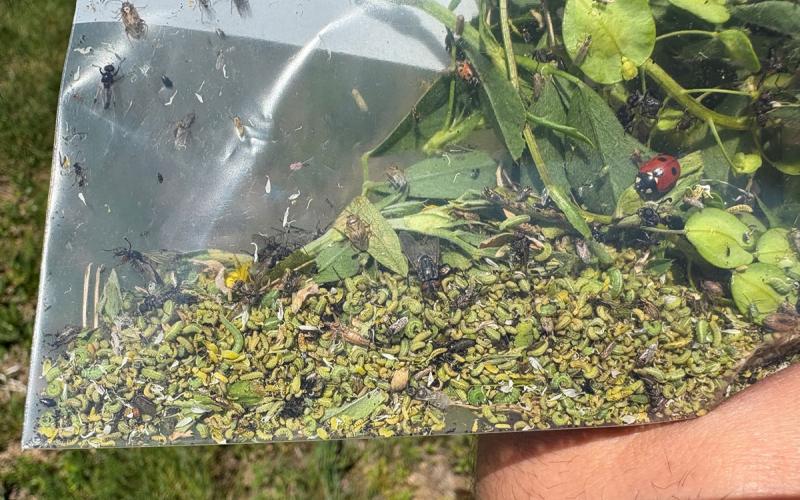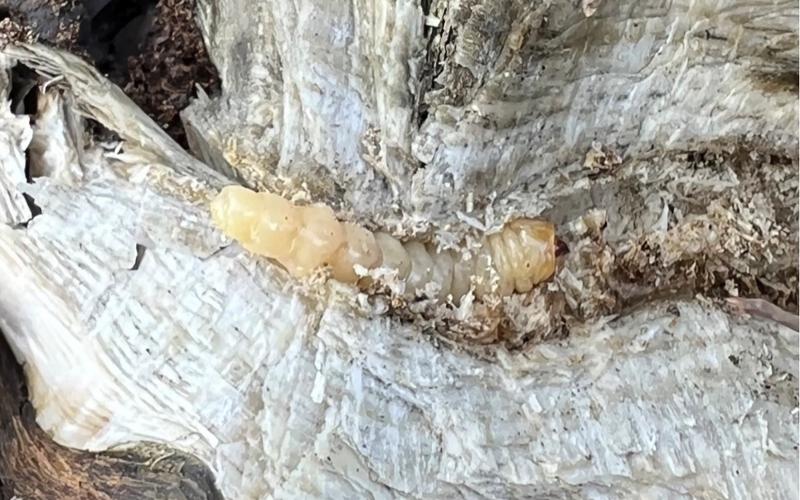
Written collaboratively by Sara Bauder and Craig Sheaffer.
Winter kill and general stand loss of alfalfa has specifically been of concern in many parts of South Dakota the last two years. Most observed alfalfa winter kill is due to low, wet or flooded areas where plants were suffocated and died over the winter.
Assess Alfalfa Stands
If extreme winter kill is observed across an alfalfa field, plant stand assessment should occur. If a field contains less than 39 stems per square foot, on average, stand replacement or modification should be considered (see stand count method below). In newly seeded or young stands, we would expect more dense stands than in older, well-established alfalfa. If a stand is mixed with grass or in a very arid climate, lower stand counts are typically acceptable.
- To estimate stems per square foot, first select four representative areas to count; keep in mind that one plant may have multiple stems. Then, use or create a 2ft2 measuring device at 17”x17” square (1/2” PVC works well) or a 19” diameter ring. Count only stems that fit within the square or ring and would be harvested by the mower (exclude those under 2” tall). Divide your count by 2 to calculate stems per square foot. Use all counts to create an average stem density estimate across the field.
Many farmers may wish to terminate thin-standing, surviving alfalfa and quickly re-seed with alfalfa. However, studies show various rotation interval recommendations for reseeding alfalfa stands, and the safest approach is to plant or interseed a different forage crop for the season and attempt to re-plant alfalfa the following spring if desired. This allows time to reduce autotoxicity as well as soil-borne diseases and other pest issues. Autotoxicity is a phenomenon that occurs when well-established alfalfa stands produce a chemical that escapes into the soil and reduces the establishment and growth of new alfalfa if seeded too soon following the old stand. Some studies show that heavier textured soils can show alfalfa autotoxicity for up to 2 years; for more info on alfalfa autotoxicity, see the University of Wisconsin’s Understanding Autotoxicity in Alfalfa.
In established stands, replanting in large, dead areas with alfalfa may be tempting if the entire alfalfa stand has completely died. However, as previously stated, re-seeding alfalfa or over-seeding into existing stands is not typically effective due to autotoxicity and pest problems. It is best to consider a different crop to re-seed in these areas.
Filling in Winter Killed Areas
If dead areas are observed in alfalfa fields, there are still some options that may provide forage and help to suppress weeds this season. Consider planting an annual forage to make up for lost feed, protect soils, and buy time until a more long term decision can be make.
Interseeding annual cool season grasses like spring wheat, oat, beardless barley, annual ryegrass, or triticale into dead or sparse areas (less than 5 plants/ft2) in alfalfa fields can provide high yielding forage for one growing season. These cool season annuals should germinate and grow quickly this spring, but growth will rapidly slow by mid-summer as temperatures pick up. These species typically provide high tonnage and adequate dry-down for baling, but those previously listed will only survive for one growing season with the exception of annual ryegrass which may persist for multiple seasons. For those interested in producing higher quality forage (with potential for less tonnage) as haylage, legumes like red clover may be more ideal when harvested at early bud stage.
If farmers are not able to enter fields this spring and become interested in forages that will produce during the summer months, warm season annuals like sorghum-sudangrasss could be considered, but because of their thick stalk, they can be difficult to dry down for hay. For younger alfalfa stands with dead patches, adding a perennial like orchardgrass, perennial ryegrass, or tall fescue can provide multiple years of productivity, however these species may likely cost more up-front and will take longer to establish. For specific information on species selection and seeding rates see the South Dakota NRCS Cover Crop Resource Page. For a full listing of all potential alternative forage crops and considerations of each, visit the University of Wisconsin-Extension’s Alternative Forage Crops website.
The most ideal interseeding equipment for these situations is a no-till drill, which will minimizes disturbance and assure seed to soil contact. Using a conventional drill (without tillage) or broadcast seeding may also work, however the stand may not be as reliable. If soils remain wet and producers cannot get into a field before the first part of May, it is best to wait until after the first cutting to try interseeding, this will provide less competition for newly seeded plants, and cause less damage to the existing stand.
Tips to Maintaining Alfalfa Following Flooding or Winter Kill
- Check soil fertility levels and reapply fertilizer if necessary.
- If herbicides are necessary, use the lowest labeled rate and avoid those absorbed through the roots or foliar systemics.
- Leave extra time before the first cutting; 10% bloom is a good goal. Allowing plants to recover and re-develop roots is an important part of maintaining future yields. Cut above the new re-growth if possible.
- Monitor and manage pest populations (plant disease, insects, and weeds) diligently to avoid any further stress in the field than has already occurred.
- If plant populations drop below 39 stems per square foot by the end of the season, it may be best to plan for a new crop next year.
- Allow time for soils to sufficiently dry before field operations take place to avoid alfalfa crown root damage.
There are no simple answers when dealing with damage to perennial forages, but with careful considerations and proper management, farmers have an opportunity to salvage old stands or seed new forage crops this year.
Resources/References:
- R. Gildersleeve, D. Undersander, and T. Wood. Seeding into an Existing Alfalfa Stand. University of Wisconsin-Extension.
Iowa State University Extension and Outreach- Northwest Iowa Dairy Outlook. Long-term flooding Can Cause Alfalfa Issues. Iowa State University Extension and Outreach. 2017. - J. Jennings. Understanding Autotoxicity in Alfalfa. University of Wisconsin-Extension.
- D. Putnam, U. Gull, B. Perez, M. Leinfelder-Miles, and R. Freeman Long. Flooding and Water-Logging Damage In Alfalfa-What to do? University of California Cooperative Extension, 2017.
- D. Undersander. Alternative forage crops. University of Wisconsin-Extension.
- D. Undersander. Assessing Alfalfa Stands. University of Wisconsin-Extension.


